#Dyslexia-Friendly Resources
Explore tagged Tumblr posts
Text
Quick Guide to Supporting Adult Learners with Dyslexia: Strategies, Resources, and Best Practices in Tertiary Education
Discover practical strategies for adult educators to effectively support learners with dyslexia. From multi-sensory approaches to assessment flexibility, this comprehensive guide offers actionable insights for inclusive tertiary education.
Supporting Adult Learners with Dyslexia: What is Dyslexia? Dyslexia is a neurological condition primarily affecting an individual’s ability to read, write, and in some cases, comprehend spoken language. Importantly, it is not a measure of intelligence or potential. Dyslexia presents as a specific learning difficulty, making tasks like decoding written words, spelling accurately, and…
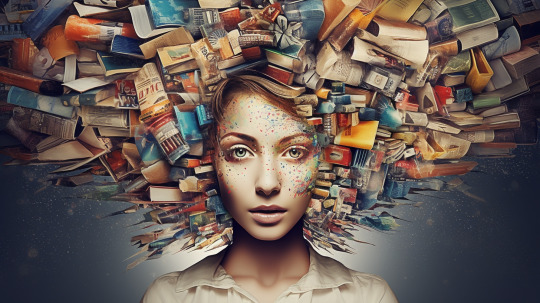
View On WordPress
#adult education#Ako Aotearoa#Assessment Flexibility#DFQM#Dyslexia Support#Dyslexia-Friendly Resources#Graeme Smith#Inclusive Education#Multi-Sensory Learning#neurodiversity#Professional Development#Tech-Assisted Learning#Tertiary Teaching#thisisgraeme
1 note
·
View note
Text
Tonight I am frustrated by the fact that I still have a lot of bias to unlearn when it comes to dealing with students with special needs
(As in, it would be nice if I could be effortlessly good at it, but alas)
#Matt has a life#Shit from work#Part of the problem (on top of like... the usual isms) is also that a) I actually *like* the traditional quiet classroom environment#just because quiet and focus is how I learn things best#also: I have limited time to prepare things like dyslexia friendly resources#I mean fortunately there's some stuff that was premade which I'll be able to modify to get started this year#unfortunately my student who probably needs it the most is not in a class where anything is ready so#more work more time needed and my availability is not moving -_-#(will still try i just don't think it'll be the greatest possible thing)#also wrt kids who probably have adhd but no other support: I have a really hard time figuring out what helps them concentrate#apart from what's actually a distraction#case in point: one time one of my students spent the full hour fiddling with paper#with no improvement that I could see in how much attention they paid to the class#and they said 'this was great I was quiet aren't you happy?'#and I was like 'well I won't lie it's convenient for me but also the goam is to help you focus#not to make things convenient'#anyway I think my main tldr is that whime there are things that exist to help these students#and I'm willing to try them#So far my attempts have felt more like randomly chucking stuff at them#(even if I ask them to tell me if they have techniques that help them already)#than anything really helpful#and I haven't figured out yet how to move past that in order to properly make things more accessible for them#(plus like. the one student who is apparently VERY dyslexic#when I asled if there might be underlying cause to their struggles in my class#strongly denied it. which adds to the difficulties)#anyway I feel like this went a little 'woe is me for dealing with this' so like#sorry about that
3 notes
·
View notes
Note
Do you happen to have any resources regarding accessibility in ttrpg design? About design, colours, phrasing of text or anything else that could be helpful!
I spent wayyyyy too long compiling all this - but it's important, and I appreciate you asking!!
Accessibility is a subject near and dear to my heart, and I will say up front that I'm not sure universal (aka accessible to everyone) design is possible, because people's needs can vary even within the same subset of similar disabilities (such as limited vision or blindness). BUT that doesn't mean we don't try to design for and make our games available to as many people as possible. Mismatch by Kat Holmes is a great read on design for accessibility in general, as is Invisible Women by Caroline Criado Perez. You might also check out literally anything Alice Wong has ever done.
To start, I recommend this article on the Lenses of Accessibility.
(for reference, this article is about web/graphic design, so I'm going to try and distill the most salient points for game design)
We are going to primarily focus on a few of these lenses:
Color
Font
Images & Icons
Layout
Readability
Structure
Keyboard
More details under the cut.
Color
Why does color matter? Well, for starters, there's a lot of colorblind people out there. Contrast affects readability. Autistic people and people who suffer from occular migraines might be affected by particular vivid colors. There's lots of reasons to consider color and the work it is doing in your piece, but in general you can provide a black and white, high contrast version of your game to help users.
There are tools out there to figure out if your contrast meets certain readability standards, such as this one.
Font
Dyslexia and other visual processing issues can make font choice really important. Plus, some fonts really affect readability. Additionally, line height, justification, and size of text can affect readability.
Best practice would be to provide a plain-text version of your game (and beware of "dyslexia-friendly" fonts which may or may not actually help - sticking to a basic readability font like Arial, Tahoma, or Verdana, is safest). I like this style guide for reference.
Images & Icons
For visually-impaired people, it's important to use alt-text, descriptions, and/or captions to help screenreaders properly translate images. Tons and tons of details that could go into this, but there are better people than me to describe it.
Layout
We've talked about this a bit, but there's tons of resources for this. There was recently a great writeup about Yazeba's Bed and Breakfast in terms of layout that I highly recommend.
Readability
More of the thing we've already talked about - it really is a combination of all the other lenses that comes down to readability. Audio versions of your game are always a good way to avoid the restrictions of screen readers, but can be expensive to produce.
Structure
This is tables. Tables are a nightmare for screenreaders, but including them as images can also be a problem. The short solution is "don't use tables" but that's not necessarily great for seeing people. The section in this blog is really great when talking about options for structure.
Keyboard
Debated on whether to include this, but given how many games are being read as purely digital files, I think it's important to have workable interactive elements that can be navigated through without a mouse. Some of that is going to come down to the programs being used to open your files. But if there are things you can do on your end (such as labeling form fillable fields on an interactive character sheet), they're worth doing!
Please understand that this isn't an exhaustive list. There's tons of resources out there and technology and standards are constantly changing.
It's also is important to note that even doing one of these things is helpful. You might look at this list and go "wow that's too hard" but I promise you, it's worth it. My games do not all have accessible versions! That's something I'm trying to rectify. The biggest part of that for me is thinking about accessibility from the start instead of at the end! But we can start today, and that's better than not starting.
The most important thing to remember are that disabled people are NOT a monolith - needs will differ from person to person. Accessible design makes gaming better for everyone!
Final Resources:
Accessibility in InDesign
Accessible-RPG
A11Y
Accessible Design for Teams
319 notes
·
View notes
Text
Bringing back this nifty little resource for checking if your game's theme(s) has good visibility:
also, here's a (supposedly) highly readable/dyslexia friendly font:
7 notes
·
View notes
Text
So You Want To Be A Professional Artist! (Free Resource for Artists by Ash Something)
So You Want to Be A Professional Artist: A guide to selling art and commissions, and other tales Written and compiled by: Ash Something
Here's a folder I put up on google drive containing both versions, as well as assets I used to create this!
Version 1: Standard formatting for general readers, in Docs format 150 pages of real-world experience being passed from ME to YOU, absolutely free! Version 2: Dyslexia-Friendly version formatted with the font OpenDyslexic (In PDF form since Google Docs didn't support the font). 289 Pages of the same, due to larger font and spacing inherent in the font design _________________ This digital document covers subjects such as: -Copyright and Trademark Law -How to brand and market yourself as an independent artist -How to arrange and present your portfolio -How to find and close commissions -The ins-and-outs of working with clients -Managing mental health while working full-time freelance, and work/life balance -Social media marketing, working within the algorithm and so forth -How to do your taxes as a self-employed individual -Free and low cost resources and how to fund your business or get started without funding
This document is FREE! Free to use, free to share, free to spread, implement or whatever else! Offered under the Creative Commons CC BY-NC-ND 4.0 License! The only thing you CAN'T DO is edit or claim it as your IP as it IS (C) Ash Something Art Help me get the word out and try to improve the lives and businesses of artists everywhere!
#art#artist#how to#art business#freelance artist#small business#artist advice#ash something#ash something art#ashsomething#ashsomethingart#writing#book#ebook#document#artists helping artists#drawing#prints#merch#free resources#artists
16 notes
·
View notes
Photo
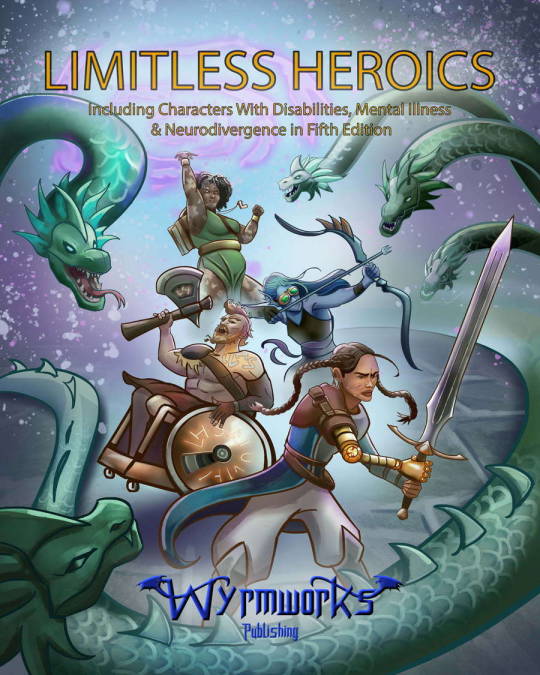
After last year’s successful kickstarter, Limitless Heroics is now available.
Limitless Heroics: Including Characters with Disabilities, Mental Illness, and Neurodivergence in Fifth Edition
When you play a tabletop role-playing game like 5e, you want to be the hero. The world is different for you having been there, better. What if you could make the real world better by playing an RPG?! That’s what Limitless Heroics is all about. Limitless Heroics is the most comprehensive disability compendium ever created for a Tabletop Role-Playing Game. For Fifth Edition, it provides:
450+ Traits: Game mechanics for nearly every condition or trait in existence (plus some fantasy traits, because that’s what you should expect in a world with magic) with 4 Impact Extents, and 6 Frequencies. With 1–6 traits per character (or more), that’s 64,800+ combinations with the option to add more.
78 Random tables to choose or generate the traits, their Impact Extent, and their frequency (Get a free ashcan sample with all the tables from the book.)
200+ New Magic Items and an online random generator for thousands more! Nearly every trait includes mundane and magic assistive options.
4 New Monster Stat Blocks because sometimes, the disability or assistive device is a creature.
6 New Spells because sometimes, assistance comes from a spellbook
Service animals designed as classes (similar to sidekicks)
50 Example NPCs, fully illustrated, ready to use
A one-shot adventure
Thousands of real world examples so players can learn more and better represent the traits
Tutorials: Opening articles discuss how and why to implement these options, how to discuss it with your players, and common tropes to avoid. You have all the tools here to run an inclusive campaign.
Our website will have a free random generator to simplify determining character traits, but you’ll need the book for the descriptions and mechanics, or you can use the included tables to choose or roll manually.

We talked to dozens of people with diverse conditions to make sure our game mechanics represented their experiences before writing it, and over 900 people looked at the manuscript draft, and we got 90 pages of feedback from their experiences!
All writers, editors, and artists hired for this book are disabled, neurodivergent, and/or have mental or chronic illness.
Book Accessibility
Dyslexia-friendly layout
PDF, ePub, and plain text versions
Fully screen reader accessible
Indexed audio version included with every digital purchase
A player’s edition of the book is also available:
The Players Edition of Limitless Heroics includes everything in the full book except the adventure, magic items, and NPCs, reducing the size and associated costs by 346 pages. If you plan to use these resources in settings where you need multiple copies (e.g. schools, clinics, community organizations, etc.), this will save you some money.
81 notes
·
View notes
Text



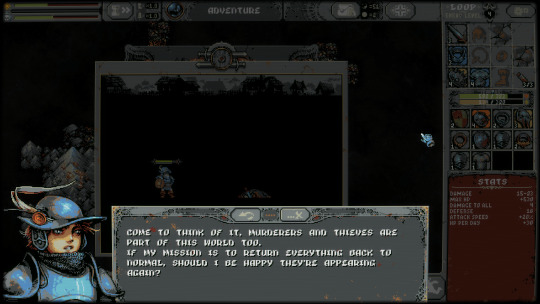



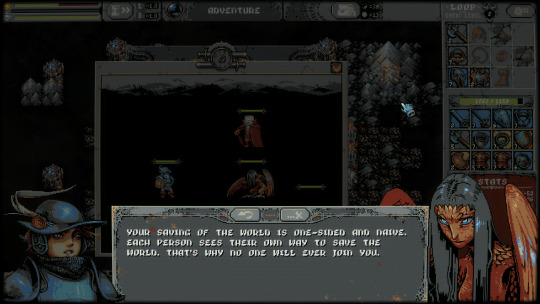
it's been a while since i last shared a game i've been playing. april was spent with stardew valley and i've taken a break from it recently, which i've been spending with the incredible loop hero (dev. four quarters). i believe it's available on all platforms except playstation; it also came out on mobile in the last couple of days. i've been splitting my game time between pc and the steam deck and it plays really well on both. all pictures are completely unedited, my thoughts are below
loop hero is the bastard child of roguelite, deck builder, dungeon crawler, and class-based numbers machine elements. it is set in a post apocalyptic world transformed into a void by sans undertale a lich. all that is left is the loop, which the protagonist wanders endlessly until death or retreat. the loop starts and ends at the campsite, after which the creature and loot level will increase. the protagonist has vague memories of the world, which he imposes through the form of cards. each card is a tile with different properties, both positive and negative to the player. some come with enemy spawns which the protagonist battles automatically. the core gameplay mechanic hinges on knowing what cards to put, and where and when to do so. in a way, the player is the dm in this campaign. more cards can unwittingly bring more dangers, but it is through defeating enemies that one can get more cards and better loot to combat the increasing difficulty that comes with each loot. cards can also interact with others in ways that aren't predictable at first, but can give benefits down the line. there is a meter that indicates when enough cards have been placed in order to summon the chapter boss. during runs, resources can be gathered to improve the base camp, which makes this game lean roguelite, as it allows for progression between runs. some amount of resources is always brought back, but it depends on whether the player has died, retreated outside the camp tile, or retreated in the camp tile (the best outcome for resource gathering). certain base camp updates may also unlock different classes.
i found the writing to be really good so far. it is simple. no character is named and details are vague in a way i find murakami-esque. i think it's lovely that the hero is so strongly motivated to restore the world for, even if that means bringing dangerous people and creatures back. each time a new verbal enemy type is spawned and fought, there is a dialogue in which the protagonist tries to reason with them. i found it to be a nice humanizing touch. there is also a strong element of community as the base camp is expanded to accommodate new characters (who are all hot smh) who all provide support based on their building/profession. they're great. i have just defeated the first boss and don't know what comes next, but it seems that there is more to the initial premise than it first appears.
visually i find the game gorgeous, the devs did an amazing work with the pixel art, which is one of the most gorgeous i've seen in gaming. there are options to toggle a crt shader (which i have enabled in these pictures) and different font options for readability. i found the most stylized default font to be very readable for me, but the game features a simple sans-serif font and a sans-serif dyslexia-friendly font in addition. the soundtrack also leans heavy into the 8bit era of gaming aesthetics. it also has bangers such as this song that plays once the first boss appears.
6 notes
·
View notes
Note
If they had a kid meme, harker & jesper and darby & ivan ❤️
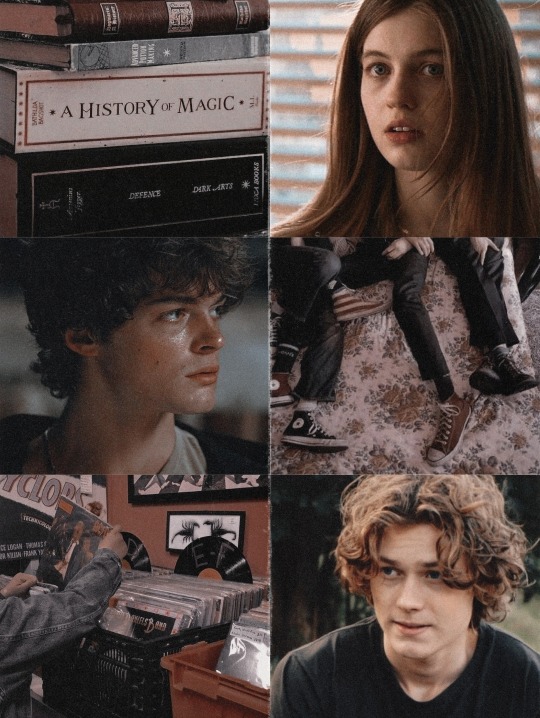
Name: Maeve Ursula Greenaway
Gender: female (she/her)
General appearance: light brown hair, blue eyes, average height
Personality: book smart, honest, hard-working, focused, driven, reckless, reserved, practical
Special talents: flying, wizard chess and gobstones (games in general)
Who they like better: Harker
Who they take after more: Harker
Personal headcanon:
She's a Gryffindor and plays Quidditch as a chaser. Eldest of the siblings. Protective of her brothers, eldest sister syndrome. Maeve and her brothers are adopted. As the eldest, Maeve remembers their birth-parents the best.
Face Claim: Olivia Scott Welch


Name: Cole Rafael Greenaway
Gender: male (he/him)
General appearance: brown hair, green eyes, kind of short
Personality: flirty, charming, out-going, arrogant, protective, resourceful
Special talents: dancing, duelling
Who they like better: Harker
Who they take after more: Jesper
Personal headcanon:
Slytherin, middle child. Teases his younger brother constantly but will fight you if you tease him. Legilimens.
Face Claim: Tyler Lawrence Gray


Name: Hilary Jaren Greenaway
Gender: male (he/him)
General appearance: sandy blond hair, blue eyes, tall
Personality: awkward, sensitive, irritable, loyal to his loved ones, suspicious of others, introverted
Special talents: knows a lot about music, can play drums, athletic
Who they like better: Harker
Who they take after more: Harker
Personal headcanon:
Hufflepuff. Plays Quidditch as a beater. Doesn't do that well academically, has dyslexia.
Face Claim: Adrian Öjvindsson


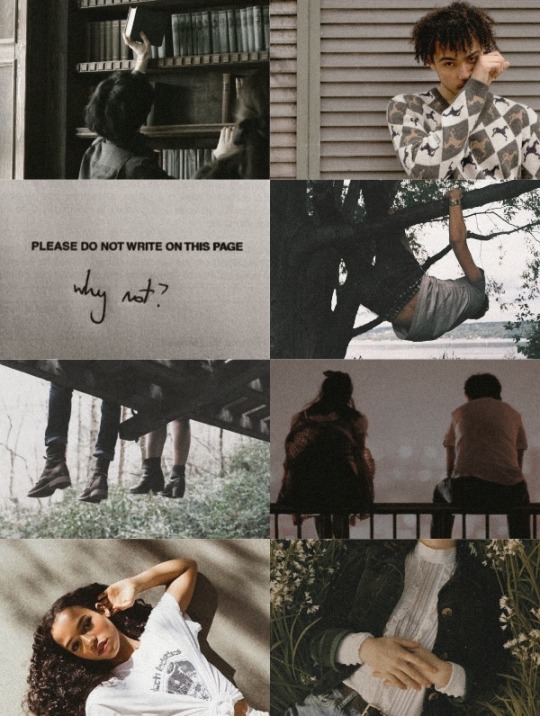
Name: Riot Travis Rosen
Gender: male (he/him)
General appearance: dark, curly hair, brown eyes, very tall
Personality: rebellious, cocky, critical, witty, intelligent, skeptical, compassionate
Special talents: conversation, impressing people
Who they like better: Both
Who they take after more: Ivan
Personal headcanon:
Slytherin. Passionate about politics. Popular in school, is friendly but can be judgemental. Better at theoretical subjects than practical subjects. Younger twin.
Face Claim: Archie Madekwe


Name: Rhyme Maddox Rosen
Gender: female (she/her)
General appearance: dark, curly hair, brown eyes, average height
Personality: aloof, independent, adaptale, genuine, funny, creative
Special talents: singing
Who they like better: Darby
Who they take after more: Ivan
Personal headcanon:
Ravenclaw. Likes music a lot. She's not super popular in school but has her own circle of friends. Older twin.
Face Claim: Taylor Russell
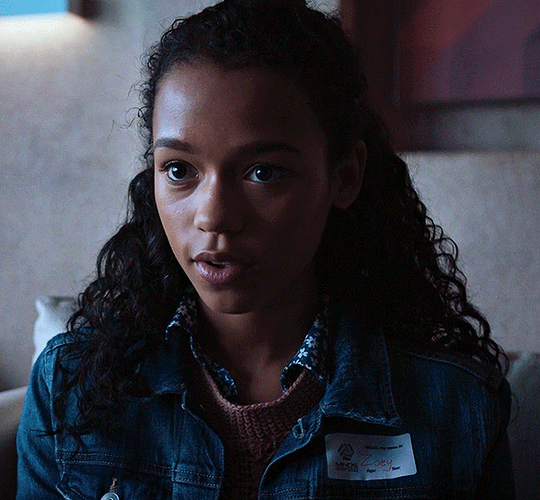
#jesus this took forever#if they had a kid meme#harper#maeve greenaway#cole greenaway#hilary greenaway#riot rosen#rhyme rosen#darbyvan#welcome into the canon you absolute rascals#*mine#what do you mean IF??? they DID have SEVERAL kids and now they're everybody's problem
6 notes
·
View notes
Text
Unleashing the Power of Audiobooks: A Gateway to Learning and Entertainment Shaina Tranquilino November 7, 2023

In an era where multitasking has become the norm, finding time to read a good book can be quite challenging. However, with the rise of audiobooks, literature enthusiasts are discovering a new way to indulge in their favourite stories. The convenience and accessibility of audiobooks have revolutionized the reading landscape, offering a plethora of benefits that extend beyond mere entertainment. In this blog post, we will explore how audiobooks have proven to be an invaluable resource by enhancing learning experiences, fostering literacy, and enabling individuals to maximize their time.
1. Accessibility for All: One of the most significant advantages of audiobooks is their ability to cater to diverse audiences. People with visual impairments or learning disabilities can now access literature effortlessly through audio formats. Additionally, those who struggle with reading due to dyslexia or language barriers find relief in the spoken word format. Audiobooks provide equal opportunities for everyone to engage with books and experience the joy of storytelling.
2. Enhanced Learning Experiences: Audiobooks are not limited to fiction; they also encompass educational content across various disciplines. From self-help guides and biographies to classic literature and scientific research, these audio companions offer an immersive experience that enhances learning outcomes. By combining auditory stimulation with written text, listeners can absorb information more effectively and retain knowledge for longer periods.
3. Multitasking Made Easy: The fast-paced nature of modern life often leaves little room for dedicated reading sessions. However, audiobooks allow us to transform mundane activities into engaging experiences by combining them with literary adventures. Whether you're commuting, exercising, cooking, or simply relaxing at home, immersing yourself in an audiobook enables you to make use of every spare moment without compromising on intellectual or recreational pursuits.
4. Improving Pronunciation and Language Skills: Listening skills play a crucial role in language acquisition, and audiobooks provide an exceptional platform for improving pronunciation and fluency. By following along with the narration, listeners can absorb correct intonation, rhythm, and accentuation. This practice not only benefits language learners but also helps native speakers refine their linguistic skills.
5. Sparking Imagination and Creativity: Audiobooks have a unique ability to bring stories to life through voice acting, sound effects, and music. These elements enhance the narrative experience by creating vivid mental images that captivate the mind's eye. Whether it's an epic fantasy or a gripping crime thriller, these auditory stimuli transport listeners into imaginative worlds where they become active participants in the storytelling process.
Audiobooks offer a modern solution to the perennial problem of finding time to read. They transcend barriers imposed by busy schedules, disabilities, or language constraints. With their accessibility, educational potential, multitasking-friendly nature, and ability to stimulate imagination, audiobooks have proven themselves as invaluable companions on our literary journeys. So if you haven't already embraced this innovative format of reading, why not give it a try? Let audiobooks revolutionize your reading experience while you savour captivating tales that ignite your imagination and expand your horizons like never before!
#audio books#book lover#reading#reading community#audible#bookworms#listening is learning#audio book love#audio addict#literary escape#story telling magic#audiobook
3 notes
·
View notes
Text
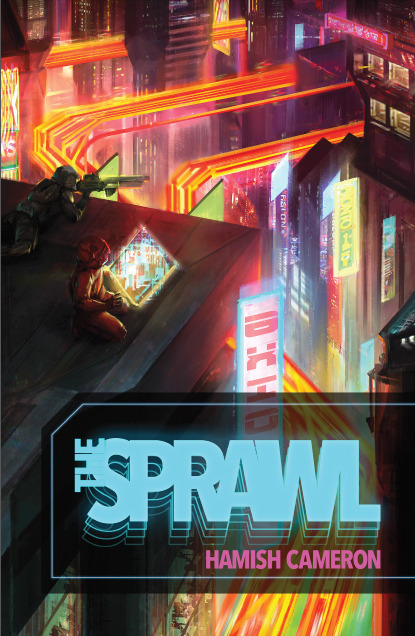

Usability: Great RPG Mechanics #RPGMechanics: Week Nine
Continuing my week of meta-elements which make for great games, I want to talk about physical presentation. There’s a weird mix in my collection of ttrpgs. I have 8-9 shelves filled with physical books and way, way too many accumulated in my badly organized “rpg e-files” folder which has migrated across five different desktops. I’d say pdfs have become the majority at this point. I usually read those on a crappy Samsung tablet, mostly because I have a hard time reading large amounts of text on a screen. So pdfs work better than others– and I appreciate when the designers have thought about these elements.
Printer-Friendly: I love it when a ttrpg has a printer friendly mode. This can take a couple of forms. Some games, like The Sprawl, have a day-mode and night-mode versions. When I first saw the Sprawl’s white text on black background, I didn’t like it. Eventually I found out that was a more comfortable approach for a lot of readers. But I appreciated that Hamish Cameron eventually released a version with standard black on white page design. Other games publishers in the last few years have begun to do this more and more. Star Trek Adventures includes that with the pdf purchase.
The other version of printer/reader friendly is to have layers available in the pdf. This allows readers to turn off distracting page elements: paper textures, watermark art, intrusive page frames. This allows for easier printing, but frankly for me, it makes for easier reading. It just makes me unreasonably angry when I get a pdf with page backgrounds that make it harder for my old person's eyes and I can’t turn those off. Sometimes a pdf will have layers but turning off the backgrounds removes the text as well because they’ve merged the two together. The best games have layers, cleanly separated and cleanly labeled.
Give Me Text: Some games in recent years have offered text-only versions, like The Veil. I love this. It is hugely useful and makes it more likely that I’m going to run that game. I run the majority of my ttrpgs online. Usually that means I’m putting together materials for the players: setting background, cheat sheets, and character keepers. Extracting text from pdfs is a pain, even with a good program. You almost always have to deal with the paragraph breaks and formatting. When a company provides the text, it makes my job significantly easier. If you want people to play your game online, outside of a set VTT package, include the text with the pdf. A lot of folks on itch.io know to do this.
Accessibility: There are a couple of elements which I can’t speak to from experience, but I appreciate when I hear about publishers who spend the extra time getting these things right. My father was color blind and the few board games he played with us often had to be modified to make up for that. Some companies use online tools to check how their material works for the color blind. That’s important where color is used to mark out important information: particularly different colors to indicate different things.
On the other hand, one complaint I’ve heard about certain books is that they’re particularly dyslexia-unfriendly. They choose fonts which look cool but become a pain to actually read for people with this condition. I know tools and resources exist for checking which fonts work better than others. Of course it isn’t just about fonts, but general typographic elements, size, background bits, etc. When I designed the earlier Gauntlet Community revised logos, I had input from a couple of folks who encouraged me to move clutter away from the words and remove some extra type flourishes. It looked better and became more useful as a result.
6 notes
·
View notes
Text
Effective Strategies for Supporting Neurodiverse Adult Learners: A Conversation with Annette Tofaeono
Unlock the power of inclusive education with effective neurodiversity strategies for educators. Learn how to create an inclusive classroom, implement learning techniques, and communicate effectively.
Working with Neurodiverse Learners – What Are Some Strategies You Can Use? Part 1 Welcome back to our ongoing series on neurodiversity and learning differences. In this third instalment, my colleague and friend Annette and I explore the essential strategies for working with adult students who may have learning differences. Inclusive Classroom Culture Annette starts by emphasising the…

View On WordPress
#adult education#Alternative Assessments#Annette Tofaeono#Classroom Culture#Communication Techniques#Dyslexia Resources#Dyslexia-Friendly#Educational Support#Graeme Smith#Inclusive Education#inclusive learning environment#learning differences#neurodiversity#Stress-Free Environment#teaching strategies#thisisgraeme
1 note
·
View note
Text
26 Jan 2023: Things to check/ action...
'Starter activity' evidence (embedding English, Maths, Digital, E&D)
'Prevent' evidence?
'Peer-Observation activity' evidence (rationale and reflection on usage/ application in practice) - on completion upload into section 5!
-------------------------------------------------------------------
'Adaptive teaching' V Differentiation (What is the Difference?)
NEW ACTVITY: You need to consider the challenges faced in your subject specialism and discuss how you adopting inclusive pedagogic approaches in your classrooms...
'Adaptive Teaching?' Task : Identify where and how this is relevant in your subject specialism (issues may include: meeting higher level learning needs, students with EAL or challenging behaviours, SEND/ other learning needs such as students on dyslexia, ADHD and autism spectrums, or it might be those students who demonstrate low confidence/ negative prior learning experiences etc...). (On completion, upload this evidence into Section 1/ and reflect on ILP).
Some useful resources if relevant:
Decolonising the curriculum toolkit
Decolonising the curriculum – how to get started
ETF ESOL resources
ETF resources for those teaching pre-entry ESOL
EAL Pedagogy
Teaching English, maths and ESOL post-covid ETF resource
SEND Code of Practice.gov
Conference interview with Palfrey on Safe Spaces, Brave Spaces
OU resources on diversity in the curriculum
Mental Capacity (Amendment) Act 2019
Social Care Institute of Excellence
DHSC full set of factsheets
EEF resource on adaptive teaching
E-book written for those with Asperger Syndrome
British Dyslexia Association website
Case studies of supporting those with dyslexia / SpLD friendly approaches for FE The National Autistic Society – links to their magazine.
Note: this may well feed into your selected 'wider perspectives'' assignment? Just a thought...
2 notes
·
View notes
Text
someone please make dyslexia and dyscalculia friendly resources
stop using chatgpt!!!! take a bronze pin and carve your questions onto an ox scapula, then toss it into the fire!!!! use the cracks to divine the gods answer!!!!
63K notes
·
View notes
Note
Do you have a simple beginner level guide for crocheting a baby cardigan as I am struggling to find one with layman terms and easy to follow as I have slight dyslexia
One thing that might help is following a video. I know written patterns can sometimes seem like a slog to read through (I've crocheted for 15+ and I still have to look back at the glossary to see what the heck I'm supposed to do). There were no crochet/knitting videos when I was first learning, so I think it's so amazing now how many different resources are available.
So I've not crocheted a baby cardigan before (I usually knit baby clothes), but these tutorials look beginner friendly to me:
youtube
youtube
youtube
These all have written patterns available too, so you can follow along with the video as you read through your pattern.
1 note
·
View note
Text
The Rise of Audiobooks for Students from Class 6 to 12: A Modern Learning Tool
Download the App
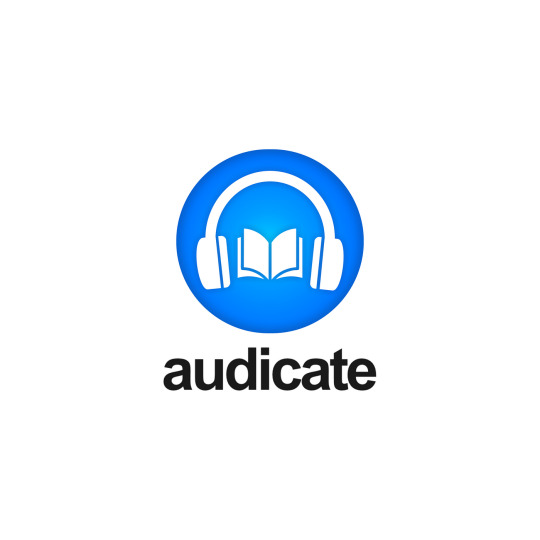
In today’s fast-paced world, traditional learning methods are rapidly evolving. Students from Class 6 to 12 are now seeking alternative ways to enhance their academic experience, one of the most popular being audiobooks. Audiobooks offer a flexible and engaging method of learning that can complement textbooks, helping students grasp complex concepts more easily. With advancements in technology and the increasing accessibility of educational content, platforms like Audicate are leading the way, making high-quality audiobooks a must-have learning tool for students across India.
The Growing Popularity of Audiobooks in Education
Audiobooks have gained significant traction in recent years, especially in the education sector. Here are some reasons why audiobooks are becoming an essential resource for students from Class 6 to 12:
Enhanced Comprehension: Listening to content allows students to focus more on understanding the subject matter rather than worrying about pronunciation or reading pace. Audiobooks often bring concepts to life, making it easier for students to grasp difficult topics.
Learning on the Go: Unlike traditional textbooks, audiobooks offer flexibility. Students can listen to their lessons while traveling, exercising, or during breaks, making it a convenient tool for revision and learning new topics.
Multiple Sensory Learning: Listening to audiobooks engages the auditory senses, providing a different cognitive experience compared to reading. This multi-sensory approach can aid in better retention of information.
Accessibility: For students who may have difficulty reading due to visual impairments or dyslexia, audiobooks offer a valuable alternative to printed text. This inclusivity helps all students perform better academically.
Improved Vocabulary and Pronunciation: Listening to audiobooks read by professionals helps students pick up correct pronunciation and understand the context in which words are used, contributing to better language skills.
Audicate: A Leading Platform for Educational Audiobooks
When discussing audiobooks for students, Audicate stands out as a premier platform providing audio content tailored specifically for the school curriculum. Audicate has carefully curated educational audiobooks for classes ranging from 6th to 12th, covering essential subjects like Science, Mathematics, Social Studies, and Languages.
Key Features of Audicate:
Curriculum-Aligned Content: Audicate’s audiobooks are directly aligned with the curriculum prescribed by major educational boards in India, such as CBSE and ICSE. This ensures that students are listening to the exact content they need for their studies.
Interactive Learning: Audicate provides a user-friendly interface that allows students to navigate between chapters, pause, and rewind as needed. This interactive approach enables students to learn at their own pace.
Expert Narrators: Professional voice artists and subject experts narrate the content, ensuring clarity and accuracy. Their engaging tone helps maintain students' interest, making long study sessions more enjoyable.
Multi-Device Access: Audicate is available across multiple devices—smartphones, tablets, and computers—allowing students to access their audiobooks anywhere, anytime.
Affordability: One of the major advantages of Audicate is its affordability. Many students find purchasing physical textbooks burdensome, but with Audicate, they can have access to a wealth of audio resources at a fraction of the cost.
Regular Updates: Audicate continually updates its content library to keep pace with changes in school curriculums, ensuring that students always have access to the most current information.
Why Students and Parents Should Consider Audiobooks
For students between Class 6 and 12, balancing various subjects and staying on top of assignments can be overwhelming. Audiobooks offer a way to digest information more effectively and reduce study fatigue. Parents, too, are finding value in audiobooks as a tool to help their children improve focus and study habits.
Audiobooks encourage a love of learning by introducing a new, exciting way to consume information. Whether students are struggling with particular subjects or excelling and wanting to explore more advanced topics, audiobooks can cater to both ends of the academic spectrum.
Conclusion
As students move through the critical years of Class 6 to 12, the demands on their academic performance increase. Audiobooks provide a versatile and effective way to complement their learning process. Platforms like Audicate are making this transition smoother by offering educational audio content that is not only aligned with school curriculums but also accessible, engaging, and affordable.
In the future, the use of audiobooks is only set to grow as more students and parents recognize the benefits of audio learning. With platforms like Audicate leading the way, students can now listen, learn, and succeed like never before.
0 notes
Text
Enhancing Accessibility: The Multi-Functional of eBooks Over Traditional Books
1. Why eBooks are ecofriendly?
eBooks present a compelling eco-friendly alternative to traditional printed books, offering numerous environmental benefits that align with the growing emphasis on sustainability today. One of the most significant advantages of eBooks is their ability to eliminate the need for paper, thereby directly contributing to the reduction of deforestation. The process of paper production is not only resource-intensive but also detrimental to the environment, as it requires substantial amounts of water and energy. In addition, the manufacturing of paper emits greenhouse gases, exacerbating climate change. By opting for eBooks, consumers can play an active role in conserving valuable natural resources, while also helping to protect vital ecosystems that are threatened by logging and land development. Moreover, the environmental benefits of eBooks extend beyond the initial production phase. Because eBooks exist in a digital format, they generate minimal waste compared to their physical counterparts, as they do not contribute to landfill overflow when they are no longer needed. The digital distribution model further enhances their sustainability, as eBooks can be delivered instantaneously over the internet, eliminating the need for transportation and the associated carbon emissions that come with shipping printed materials. This seamless delivery method not only reduces the carbon footprint but also allows for immediate access to reading materials, promoting a culture of convenience and accessibility. Overall, eBooks represent a forward-thinking, sustainable choice that not only meets the reading needs of consumers but also aligns with the broader goals of environmental responsibility and conservation in the digital age.
2. What is the difference between eBook and printed book?
The primary distinction between eBooks and printed books resides in their format and accessibility, shaping the way readers engage with text. eBooks, as digital editions, can be accessed through various electronic devices such as e-readers, tablets, and smartphones. This digital format offers unparalleled portability, allowing users to carry an extensive library of titles conveniently in a single device. Additionally, eBooks often come equipped with interactive features, such as hyperlinks that facilitate quick navigation and adjustable font sizes to enhance readability. For avid readers who are constantly on the move, the ability to access a multitude of texts with just a few taps of their fingers underscores the modern convenience that eBooks provide. In contrast, printed books present a physical reading experience that many readers find irreplaceable. The tactile sensation of turning pages, the distinctive smell of paper, and the visual appeal of beautifully designed covers create a sensory engagement that resonates with traditional book lovers. For these readers, the act of holding a printed book can evoke nostalgia and a sense of comfort that enhances their overall reading experience. Furthermore, printed books do not rely on battery life or electronic devices, making them accessible in any environment. Ultimately, the choice between eBooks and printed books is deeply personal, influenced by individual preferences, reading habits, and the context in which one engages with literature. Each format has its unique advantages, catering to diverse lifestyles and reading preferences.
3. Can you listen to an eBook?
Listening to an audiobook is an increasingly popular and accessible method for consuming literature and information in our fast-paced world. Audiobooks, which are essentially audio renditions of written texts, provide an alternative avenue for individuals to engage with content through auditory means. This format is particularly advantageous for those with visual impairments, dyslexia, or other reading difficulties, as it allows them to enjoy and comprehend literature without the barriers that traditional print may present. Furthermore, audiobooks cater to various learning preferences, accommodating auditory learners who may find it easier to absorb information through listening rather than reading. Additionally, for those juggling busy schedules, such as commuters or multitaskers, audiobooks offer the convenience of enjoying a good book while engaging in other activities, whether it be driving, exercising, or completing household chores.
The proliferation of audiobooks has been facilitated by numerous digital platforms, which provide an extensive library of titles spanning various genres and subjects. Many of these audiobooks are narrated by skilled voice actors whose talent in modulation, tone, and character portrayal significantly enriches the storytelling experience. This aspect of narration adds a layer of engagement that can captivate listeners, drawing them into the narrative in ways that may differ from reading the text. The growth of audiobooks not only reflects a broader trend toward accommodating diverse lifestyles but also highlights the evolution of how we perceive and interact with literature in the digital age. As technology continues to advance, the popularity of audiobooks is likely to expand further, fostering a more inclusive literary landscape that encourages lifelong learning and appreciation for the written word.
4. Can I use a tablet to read eBooks?
Tablets have emerged as an exceptional device for reading eBooks, providing users with a versatile platform that accommodates a diverse array of eBook formats through various applications and online bookstores. Unlike traditional eReaders, tablets are equipped with high-resolution displays that deliver crisp, clear text and vibrant visuals, thereby enhancing the overall reading experience. This visual clarity is particularly beneficial for readers who enjoy illustrated content or graphic novels, as it brings images to life in a way that is both engaging and immersive. Moreover, many tablets come with features such as adjustable brightness settings and blue light filters, which significantly reduce eye strain during prolonged reading sessions. These technological advancements cater to the needs of readers who may spend hours engrossed in their favourite titles, ensuring a comfortable experience without compromising on visual quality. In addition to the superior display features, tablets offer remarkable portability and convenience, allowing users to download and store an extensive library of titles. This eliminates the need for physical space and enables readers to carry an entire collection of books in a single, lightweight device. The integration of functionalities such as note-taking, highlighting, and bookmarking further enhances the reading experience, making tablets an invaluable tool for students, researchers, and avid readers alike. These features not only facilitate active engagement with the text but also allow for easy reference and organization of thoughts, which is particularly advantageous for those who enjoy analysing and reflecting on their reading material. As a result, tablets are not just a practical choice for eBook enthusiasts; they represent a seamless blend of technology and literature that caters to the evolving needs of modern readers.
5. Are eBooks a good idea?
The emergence of eBooks has sparked considerable debate regarding their viability as a preferred medium for reading in an increasingly digital world. Proponents of eBooks argue that they offer unparalleled convenience, allowing users to carry an entire library within a single, lightweight device. This portability not only facilitates access to a diverse array of literature at any time and from virtually anywhere but also promotes a culture of reading that can be more readily adopted by individuals with busy lifestyles. Furthermore, eBooks frequently come equipped with a host of features designed to enhance the reading experience, such as adjustable font sizes, built-in dictionaries for quick reference, and powerful search functions that enable readers to locate specific passages or themes within texts. These functionalities can significantly enrich the engagement with the material, catering to the needs of modern readers who seek flexibility and efficiency in their literary pursuits. Conversely, critics of eBooks highlight a range of concerns that stem from the shift away from traditional print media. One of the most pressing issues is the phenomenon of screen fatigue, which can arise from prolonged exposure to digital devices. This fatigue can lead to discomfort and reduced concentration, detracting from the immersive experience that physical books traditionally provide. Additionally, the tactile engagement associated with turning pages and the sensory pleasure of holding a physical book are aspects that many readers cherish and feel are diminished in the digital format. The tactile experience not only contributes to the overall enjoyment of reading but also aids in memory retention and comprehension. Ultimately, the efficacy of eBooks versus traditional books may depend on individual preferences and reading habits, warranting a nuanced evaluation that considers both the advantages of digital literacy and the enduring appeal of physical books. As technology continues to evolve, the literary landscape will likely adapt, reflecting a variety of reading experiences that cater to diverse audiences.

0 notes